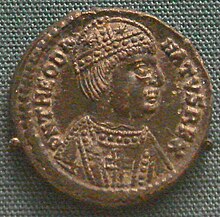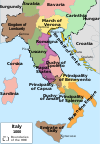Theodahad
This article has multiple issues. Please help improve it or discuss these issues on the talk page. (Learn how and when to remove these template messages)
|
| Theodahad | |
|---|---|
 | |
| King of the Ostrogoths | |
| Reign | 534 – c. December 536 |
| Predecessor | Athalaric |
| Successor | Vitiges |
| Co-monarch | Amalasuintha (until 535) |
| Born | c. 480 Tauresium, Eastern Roman Empire |
| Died | December 536 (aged 56) |
| Spouse | Gudeliva |
| Issue | Theudigisel, Theodenantha[3] |
| Mother | Amalafrida |


Theodahad, also known as Thiudahad (Latin: Flavius Theodahatus Rex, Theodahadus, Theodatus; c. 480 – December 536), was the co-monarch of the Ostrogothic Kingdom with his cousin Amalasuintha in 534 and became the sole ruler from April 535 until his death in December 536. In contrast to the reign of Theodoric the Great, Theodahad's rule is generally regarded as a failure.[4]
Early life
[edit]Born in Tauresium, now in North Macedonia, around 480, Theodahad was the nephew of Theodoric the Great[5] through his mother, Amalafrida. He was likely the son of Amalafrida's first husband, as her second marriage occurred around 500.[citation needed] His sister was Amalaberga, and his father's identity remains unknown.[citation needed]
Theodahad may have arrived in Italy with Theodoric and was likely elderly at the time of his accession. According to Massimiliano Vitiello, the name "Theodahad" is a compound of the words for 'people' and 'conflict'.
In his early life, Theodahad studied Plato and other Greek philosophers and amassed considerable wealth through property acquisitions in Tuscany,[6] Italy, sometimes employing violent methods. He was later compelled to compensate citizens for land he had seized after a Byzantine envoy, sent by Queen Amalasuintha—who was ruling in her son's stead—arrived in Rome and Ravenna.[7] Procopius's Chronicles recount that Amalasuintha sent letters to the Byzantine Emperor Justinian I,[8] seeking his support for her rule and addressing Theodahad's attempts to sell the land he had acquired to Byzantine nobles and even to Justinian himself. Theodahad had a wife and three children: two sons, including Theodegisclus, and a daughter named Theodenanthe, both of whom are mentioned in Procopius's writings.[9]
King and Accession to the Throne
[edit]Although Theodahad was born into nobility in the Ostrogothic Kingdom, it appears he was never considered a serious heir to the throne by Theodoric. This view is supported by historians and is evidenced by Theodahad's lack of battlefield experience. Initially dismissed as slander by Procopius, this assessment has since gained scholarly support.
Theodahad's cousin, Amalasuintha, ruled as regent for ten years on behalf of her son Athalaric and continued to govern after his death. Her pro-Byzantine stance and gender made her a target of opposition from many Ostrogothic nobles, some of whom were executed for alleged plots against her. To bolster her position, Amalasuintha appointed Theodahad as co-monarch. Before this appointment, Theodahad had to swear loyalty to Amalasuintha and marry into the line of succession, aligning himself with Emperor Justinian I.
Amalasuintha hoped to rehabilitate Theodahad's reputation following his controversial land acquisitions in Tuscany, urging the Roman Senate to recognize him as a capable landowner who could contribute to the kingdom's prosperity. However, her efforts met with mixed results. While Amalasuintha struggled to gain support due to her gender and connections to Constantinople, Theodahad remained unpopular among the nobility.
Amalasuintha also had to prepare Theodahad for the responsibilities of kingship, as he had not been groomed for the throne by his predecessor Theodoric.[10] Theodahad's lack of interest in learning about governance suggested he was reluctant to rule.[5] His early life focused on acquiring and selling land, possibly in preparation for retirement in the East.
Resentful of Amalasuintha for her actions in Tuscany, Theodahad eventually had her exiled to an island in Lake Bolsena[11] near Orvieto, where she was assassinated. In response to her death, Emperor Justinian I initiated military actions in Sicily, marking the beginning of the Gothic Wars.
Gothic War
[edit]Following the death of Amalasuintha, Emperor Justinian I seized the opportunity to invade Sicily, swiftly conquering it in hopes of reuniting the Eastern and Western Roman Empires. In response, Theodahad sought to negotiate peace with the envoys sent by Justinian before the invasion began, hoping to secure his freedom by potentially selling the kingdom.
Justinian dispatched one of his most capable commanders, Belisarius, to conquer Italy from Theodahad and the Ostrogoths. Ill-prepared for the demands of war due to his lack of experience and knowledge, Theodahad struggled to mount an effective defense.[9]
Theodahad's son-in-law, Ebremud, was sent to face Belisarius but deserted the Gothic forces upon encountering him. Despite having studied Plato, Theodahad failed to strengthen his armies after initiating negotiations with Constantinople. As he took refuge in the cities of Ravenna and Rome, dissatisfaction grew among the Goths due to his inadequate preparation for war and his refusal to assist the besieged city of Naples. This discontent led to the election of a new king, Witiges, a former general under Theodoric the Great.
Upon learning of Witiges's election, Theodahad returned to Ravenna in an attempt to reclaim control and secure himself from the advancing Byzantine forces. During this retreat, Witiges sent a Goth named Optaris to either capture or kill Theodahad. Optaris, who harbored personal grievances against Theodahad due to his actions towards a woman Optaris had courted, succeeded in killing Theodahad.
Following Theodahad's death, Witiges was declared king of the Ostrogoths.[6]
In fiction
[edit]Theodahad is featured in Felix Dahn's 1876 historical novel Ein Kampf um Rom, which was translated into English in 1878 as A Struggle for Rome. In this novel, he is portrayed as weak and subservient to his wife, Gothelinda, who is depicted as the true orchestrator of Amalasuintha's murder.
Theodahad also appears, under the name "Thiudahad," in L. Sprague de Camp's 1939 alternate history novel Lest Darkness Fall.[11][12]
References
[edit]- ^ Hodgkin, Thomas (1896). Italy and Her Invaders. Clarendon Press. p. 651. ISBN 9788482770321.
- ^ Lillington-Martin, C. (2016), a review of Theodahad: A Platonic King at the Collapse of Ostrogothic Italy by Massimiliano Vitiello (2014) for University of Toronto Quarterly, Issue 85:3 (2016), 470-472. https://dx.doi.org/10.3138/utq.85.3.470.
- ^ Arnold H.M. Jones et al. (ed.), The Prosopography of the Later Roman Empire: Volume 2, AD 395-527, Cambridge: University of Cambridge Press 1980, p. 1067.
- ^ Heather, Peter J. Empires, and barbarians: The fall of Rome and the birth of Europe. New York, New York: Oxford Univ. Press, 2009.
- ^ a b Arnold, Jonathan J. Theoderic, and the Roman Imperial Restoration. New York, New York: Cambridge University Press, 2018.
- ^ a b Procopius. “History of the Wars, Books V and VI: The Gothic War.” Translated by Charles C Mierow. The Project Gutenberg eBook of Procopius’ History of the Wars, Books V And VI: The Gothic War, by Procopius., January 2019. https://www.gutenberg.org/cache/epub/20298/pg20298-images.html .
- ^ Jordanes. “Jordanes : Getica: The Origin and Deeds of the Goths, c. 551 CE.” Translated by Charles C Mierow. Internet history sourcebooks: Medieval sourcebook, 2019. https://sourcebooks.fordham.edu/source/jordanes-historygoths.asp .
- ^ Amalasuntha. “Amalasuntha.” Translated by H B Dewing. Epistolae, 2014. https://epistolae.ctl.columbia.edu/woman/26057.html .
- ^ a b Vitiello, Massimiliano. Theodahad: A Platonic king at the collapse of Ostrogothic Italy. PDF. Toronto, Ontario: University of Toronto Press, 2014.
- ^ Amory, Patrick. People and Identity in Ostrogothic Italy: 489-554. New York, New York: Cambridge Univ. Press, 1997.
- ^ a b Walton Beacham; Suzanne Niemeyer (1987). Popular World Fiction, 1900-present: A-De. Beacham Publishing. p. 419. ISBN 978-0-933833-08-1.
- ^ Frank Northen Magill (1979). Survey of Science Fiction Literature: Five Hundred 2,000-word Essay Reviews of World-famous Science Fiction Novels with 2,500 Bibliographical References. Salem Press. pp. 1198–1201. ISBN 978-0-89356-194-9.

